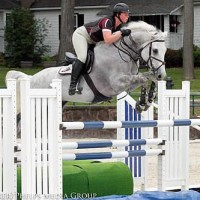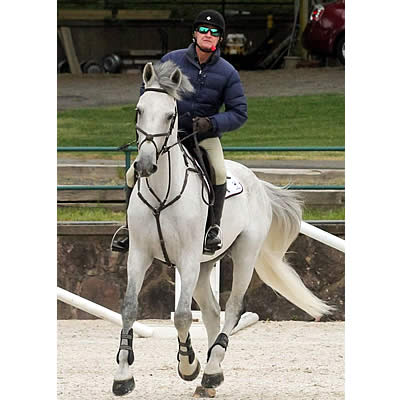George H. Morris rides Aslan.
Gladstone, NJ – May 21, 2015 – After two days of solid flatwork, the riders at the United States Equestrian Team Foundation’s “Gladstone Program” were feeling eager to transfer their newly acquired knowledge of classical riding from the flat to the fences.
George H. Morris, Katie Cox, Kilian McGrath and Sean Leckie rode into the arena not a minute past 8 a.m., while Lisa Goldman looked on from the sidelines as Morris piloted her ride, Aslan.
The large outdoor ring was set up with a number of obstacles, including cavaletti, a four-jump bounce, a triple combination, a single jump and a skinny fence. In the middle sat an oxer with a rolltop and liverpool underneath, which Morris explained was preparation for the water jump.
The riders began warming up their horses at a slow trot, keeping their inside legs and rein contact steady to encourage the horses to move with impulsion and soften at the poll, reaching for contact with the bit.
“You have to ride the horse into your hands with your legs,” Morris explained. “You have to acquire perfectly steady hands.”
Morris encouraged the riders to frequently change directions, make transitions, and ride shoulder-in and haunches-in, using half halts throughout to help the horses loosen up and engage their hind ends.
“What’s my secret?” Morris boomed over the loudspeaker. “My secret is my legs. My secret is to give and take with my hands. My secret is suppleness.”
Morris instructed the riders to have a deep seat, but to lean forward so the horses could move freely. When everyone demonstrated a controlled trot at various stride lengths, the group moved on to the canter and counter canter, incorporating half passes and flying lead changes.
“It’s just like going to the gym,” Morris said. “The muscles are working and changing. I don’t know all the Latin names like Dr. Heuschmann, but I know by the feel.”
When the horses were warmed up and ready to jump, Morris reluctantly returned Aslan to Goldman, saying, “Wow, that’s a horse.”

The riders took turns going through the bounce, continuing to work on driving from their legs to their hands. From there, the riders tackled the outside combination, and finally, moved on to the big liverpool oxer, making a sharp rollback to the skinny.
Morris asked the riders get in a light seat, lengthening and collecting their horses around the arena, working on setting the “pace to the base” of the jump.
Once the jumps were raised and everyone had completed the short course to Morris’ satisfaction, they walked their horses out as group two headed to the barn to tack up.
Shortly after, Haley Gassel, Taylor Harris and Kate Mulligan entered the ring, with Morris riding in on Sophie Verges’ mare, Q Royal Palm 2.
The riders followed Morris, walking forward with impulsion and preparing to transition smoothly to the trot with their horses rounded and collected. The riders did circles, transitions and half passes at the trot before moving to the canter to practice flying lead changes, working on staying straight throughout the change.
Once the horses were warmed up on the flat, the riders completed a balancing exercise while navigating the bounce. In their right hands, the riders formed a bridge with the reins, moving the left hand up the neck to grab mane and focusing on keeping their legs steady and eyes up.
“If you were taught this before, thank God,” Morris said. “If this is repetition and you’re bored, thank God.”
The riders moved on to the combination, jumping the first jump at an angle, skipping the middle fence, and jumping out on an angle. After a few times through that, riders jumped the whole line and continued on to make a figure eight over the fence at the top of the ring, working on making the circles smaller each time, getting their horses to listen and engage their shoulders, back and legs.
The big oxer was next up, with riders taking turns lengthening and shortening their strides on the approach to the fence before moving on to jump the skinny fence.
Morris was impressed with all the horses and riders, saying, “We have two super groups, and what horses! I’m going to buy all these horses. Very good.”
As the riders cooled the horses off at the end of a successful lesson, Morris left the group with some wise parting words: “If people and horses can’t take discipline, they won’t succeed. For one thing, the boundaries exist because this is a very dangerous sport. Second, I want excellence. That requires tough love.”
After taking care of the horses, riders headed to the farm’s historic library for a presentation about talking to the media and shaping their own personal brands.
Mason Phelps, Chip McKenney and Ariel Weisman of Phelps Media Group (PMG) educated the young riders about social media best practices, branding tips and interview strategies, closing with a mock interview and question-and-answer session.
The “Gladstone Program” will continue Friday morning with over-fences sessions at 8 a.m. and 10 a.m., and a lesson on equine nutrition with the president of Kentucky Equine Research, Dr. Joe Pagan, at 1:30 p.m. Riding sessions are open to the public for auditing.
The United States Equestrian Team Foundation (www.uset.org) is the non-profit organization that supports the competition, training, coaching, travel and educational needs of America’s elite and developing international, high-performance horses and athletes in partnership with the United States Equestrian Federation.
For more information on the USET Foundation, please call (908) 234-1251, or visit USET ONLINE at www.uset.org.
The USET Foundation has been awarded Charity Navigators’ highest honor, a Four Star rating for good governance, sound fiscal management and commitment to accountability and transparency.
Contact: Rebecca Walton
USET Foundation
phone 561.753.3389 fax 561.753.3386
rjw@phelpsmediagroup.com
PhelpsMediaGroup.com
